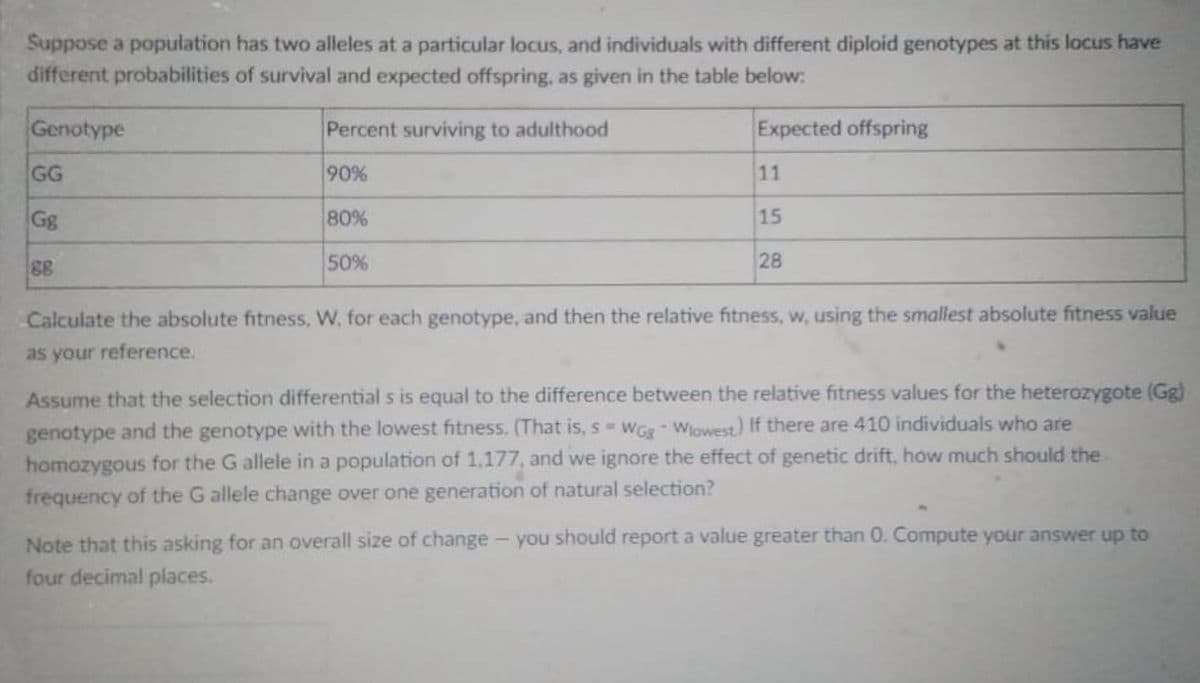Suppose a population has two alleles at a particular locus, and individuals with different diploid genotypes at this locus have different probabilities of survival and expected offspring, as given in the table below: Genotype Percent surviving to adulthood Expected offspring GG 90% 11 Gg 80% 15 88 50% 28 Calculate the absolute fitness, W, for each genotype, and then the relative fitness, w, using the smallest absolute fitness value as your reference.
Suppose a population has two alleles at a particular locus, and individuals with different diploid genotypes at this locus have different probabilities of survival and expected offspring, as given in the table below: Genotype Percent surviving to adulthood Expected offspring GG 90% 11 Gg 80% 15 88 50% 28 Calculate the absolute fitness, W, for each genotype, and then the relative fitness, w, using the smallest absolute fitness value as your reference.
Human Anatomy & Physiology (11th Edition)
11th Edition
ISBN:9780134580999
Author:Elaine N. Marieb, Katja N. Hoehn
Publisher:Elaine N. Marieb, Katja N. Hoehn
Chapter1: The Human Body: An Orientation
Section: Chapter Questions
Problem 1RQ: The correct sequence of levels forming the structural hierarchy is A. (a) organ, organ system,...
Related questions
Question

Transcribed Image Text:Suppose a population has two alleles at a particular locus, and individuals with different diploid genotypes at this locus have
different probabilities of survival and expected offspring, as given in the table below:
Genotype
Percent surviving to adulthood
Expected offspring
GG
90%
11
Gg
80%
15
g8
50%
28
Calculate the absolute fitness, W, for each genotype, and then the relative fitness, w, using the smallest absolute fitness value
as your reference.
Assume that the selection differential s is equal to the difference between the relative fitness values for the heterozygote (Gg)
genotype and the genotype with the lowest fitness. (That is, s WG Wiowest ) If there are 410 individuals who are
homozygous for the G allele in a population of 1,177, and we ignore the effect of genetic drift, how much should the
frequency of the G allele change over one generation of natural selection?
Note that this asking for an overall size of change - you should report a value greater than 0. Compute your answer up to
four decimal places.
Expert Solution
This question has been solved!
Explore an expertly crafted, step-by-step solution for a thorough understanding of key concepts.
Step by step
Solved in 2 steps

Recommended textbooks for you

Human Anatomy & Physiology (11th Edition)
Biology
ISBN:
9780134580999
Author:
Elaine N. Marieb, Katja N. Hoehn
Publisher:
PEARSON

Biology 2e
Biology
ISBN:
9781947172517
Author:
Matthew Douglas, Jung Choi, Mary Ann Clark
Publisher:
OpenStax

Anatomy & Physiology
Biology
ISBN:
9781259398629
Author:
McKinley, Michael P., O'loughlin, Valerie Dean, Bidle, Theresa Stouter
Publisher:
Mcgraw Hill Education,

Human Anatomy & Physiology (11th Edition)
Biology
ISBN:
9780134580999
Author:
Elaine N. Marieb, Katja N. Hoehn
Publisher:
PEARSON

Biology 2e
Biology
ISBN:
9781947172517
Author:
Matthew Douglas, Jung Choi, Mary Ann Clark
Publisher:
OpenStax

Anatomy & Physiology
Biology
ISBN:
9781259398629
Author:
McKinley, Michael P., O'loughlin, Valerie Dean, Bidle, Theresa Stouter
Publisher:
Mcgraw Hill Education,

Molecular Biology of the Cell (Sixth Edition)
Biology
ISBN:
9780815344322
Author:
Bruce Alberts, Alexander D. Johnson, Julian Lewis, David Morgan, Martin Raff, Keith Roberts, Peter Walter
Publisher:
W. W. Norton & Company

Laboratory Manual For Human Anatomy & Physiology
Biology
ISBN:
9781260159363
Author:
Martin, Terry R., Prentice-craver, Cynthia
Publisher:
McGraw-Hill Publishing Co.

Inquiry Into Life (16th Edition)
Biology
ISBN:
9781260231700
Author:
Sylvia S. Mader, Michael Windelspecht
Publisher:
McGraw Hill Education